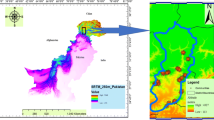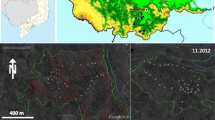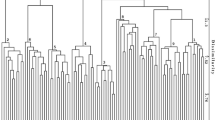Abstract
Situated at the interface of Central European and Illyrian vegetation, the mesic forests of southwestern Hungary occupy a special position. Despite their importance in vegetation science and conservation, a comprehensive study of the Illyrian mesic forests of the Villány Mts, the southernmost mountain region in Hungary, has not been provided yet. In this study 60 phytocoenological relevés were prepared in the beech, oak-hornbeam, ravine and scree forests of the Villány Mts. To compare the individual associations, we performed a PCoA-ordination, calculated the per plot species number and the per plot protected species number, computed the percentage constancy values of the protected species, identified significant diagnostic species, and prepared the spectra of the coenological preference groups. We used relative ecological indicator values to assess habitat conditions. The PCoA-ordination, the coenological preference group spectra, and to a certain extent the ecological indicator values suggested that the different mesic forests of the Villány Mts show certain similarities. This is probably due to the fact that beech forests and ravine forests are confined to small and atypical stands by the suboptimal environmental conditions. Nonetheless, the number of diagnostic species and the constancy values of protected plants indicated that significant differences do exist between the four associations, the scree forest being the most distinct. We conclude that oak-hornbeam forests and scree forests of the Villány Mts have a regional conservation importance, while the beech and ravine forests are locally important, enhancing the structural, floristical and habitat diversity of the Villány Mts.
Similar content being viewed by others
References
Barczi A., Penksza K., Czinkota I. & Néráth M. 1997. A study of connection between certain phytoecological indicators and soil characteristics in the case of the Tihany Peninsula. Acta Bot. Hung. 40: 1–14.
Bátori Z., Csiky J., Erdős L., Morschhauser T., Török P. & Körmöczi L. 2009. Vegetation of the dolines in Mecsek Mountains (South Hungary) in relation to the local plant communities. Acta Carsologica 38: 237–252.
Bátori Z., Farkas T, Erdős L., Tölgyesi Cs., Körmöczi L. & Vojtkó A. 2014. A comparison of the vegetation of forested and nonforested solution dolines in Hungary: a preliminary study. Biologia 69: 1339–1348.
Bohn U. & Gollub G. 2007. Buchenwalder als natürliche Vegetation in Europa. Nat. Landsch. 82: 391–397.
Borhidi A. 1963. Die Zönologie des Verbandes Fagion illyricum. I. Allgemeiner Teil. Acta Bot. Hung. 9: 259–297.
Borhidi A. 1965. Die Zönologie des Verbandes Fagion illyricum. II. Systematischer Teil. Acta Bot. Hung. 11: 53–102.
Borhidi A. 1995. Social behaviour types, the naturalness and relative ecological indicator values of the higher plants in the Hungarian flora. Acta Bot. Hung. 39: 97–181.
Borhidi A. & Kevey B. 1996. An annotated checklist of the Hungarian plant communities II. The forest vegetation, pp. 95–138. In: Borhidi A. (ed.), Critical revision of the Hungarian plant communities, Janus Pannonius University, Pécs.
Borhidi A., Kevey B. & Lendvai G. 2012. Plant communities of Hungary. Akadémiai Kiadó, Budapest, 544 pp.
Borhidi A. & Sánta A. (eds) 1999. Vörös könyv Magyarország növénytársulásairól I. Természetbúvár Alapítvány Kiadó, Budapest, 362 pp.
Brus R. 2010. Growing evidence for the existence of glacial refugia of European beech (Fo,gus sylvatica L.) in the south—eastern Alps and north—western Dinaric Alps. Period. Biol. 112: 239–246.
Dénes A. 2000. A Villányi—hegység flóra— és vegetációkutatásának története, eredményeinek összefoglalása, különös tekintettel a védett és ritka fajok előfordulására. Dunántúli Dolg. Természettudományi Sorozat 10: 47–77.
Diekmann M. 2003. Species indicator values as an important tool in applied plant ecology: a review. Basic Appl. Ecol. 4: 493–506.
Dierschke H. 1997. Syntaxomomical survey of European beech forests: Some general conclusions. Ann. Bot. (Rome) 55: 17–26.
Dierschke H. & Bohn U. 2004. Eutraphente Rotbuchenwalder in Europa. Tuexenia 24: 19–56.
Dövényi Z. (ed.) 2010. Magyarország kistájainak katasztere. MTA Földrajztudományi Kutatóintézet, Budapest, 876 pp.
Dzwonko Z. & Loster S. 2000. Syntaxonomy and phytogeographical differentiation of the Fagus woods in the Southwest Balkan Peninsula. J. Veg. Sci. 11: 667–678.
Dzwonko Z., Loster S., Dubiel E. & Drenkovski R. 1999. Syntaxonomic analysis of beechwoods in Macedonia (former Republic of Yugoslavia). Phytocoenologia 29: 153–175.
Ellenberg H. 1988. Vegetation ecology of Central Europe. Fourth edition. Cambridge University Press, Cambridge, 731 pp.
Ellenberg H., Weber H.E., Düll R., Wirth V., Werner W. & Paulißen D. 1992. Zeigerwerte von Pflanzen in Mitteleuropa. Scr. Geobot. 18: 1–248.
Erdős L., Dénes A., Tolnay D., Magnes M., Bátori Z., Tölgyesi Cs. & Kevey B. 2015. Phytosociology and nature conservation value of thermophilous oak forests in a South Hungarian karst area. Austrian J. For. Sci. 132: 145–168.
Erdős L., Méri Á., Bátori Z., Gallé R. & Körmöczi L. 2012. North—south facing vegetation gradients in the Villány Mts: a case study on the population and the community level. Pak. J. Bot. 44: 927–932.
Haraszthy L. (ed) 2014. Natura 2000 fajok és élőhelyek Magyarországon. Pro Vértes Közalapítvány, Csákvár, 955 pp.
Horvát A.O. 1968. Die Hainbuchen—Eichenwalder der Mecsek—Gegend in Südungarn. Feddes Rep. 77: 163–176.
Horvát A.O. 1972. Die Vegetation des Mecsekgebirges und seiner Umgebung. Akadémiai Kiadó, Budapest, 376 pp.
Horvat I., Glavač V. & Ellenberg H. 1974. Vegetation Südost-europas. Gustav Fischer, Stuttgart, 768 pp.
Kevey B. 1984. Fragmentális szurdokerdők a Villányi-hegységben. Janus Pannonius Múz. Évk. 29: 23–28.
Kevey B. 1986. A Villányi—hegység bükkösei. Janus Pannonius Múz. Évk. 30-31: 7–9.
Kevey B. 1993. A Keleti—Mecsek szurdokerdei (Scutellario-Aceretum). Folia Comloensis 5: 29–54.
Kevey B. 2004. Dél—Dunántúl fokozottan védett növényei. Kitaibelia 9: 67–83.
Kevey B. 2008. Magyarország erdőtársulásai. Tilia 14: 1–488.
Kevey B. 2016. A Villányi—hegység gyertyános—tölgyesei. Acta Nat. Pannon. 10: 21–46.
Kevey B. & Borhidi A. 1998. Top—forest (Aconito anthorae—Fraxinetum orni), a special ecotonal case in the phytosociological system (Mecsek Mts., South Hungary). Acta Bot. Hung. 41: 27–121.
Király G. (ed.) 2007. Vörös Lista: A magyarországi edényes flóra veszélyeztetett fajai. Saját kiadás, Sopron, 73 pp.
Király G. (ed.) 2009. Új magyar füvészkönyv. Aggteleki Nemzeti Park Igazgatóság, Jósvafő, 616 pp.
Lehmann A. 1995. Földrajzi tanulmányutak a Mecseken és környékén. Janus Pannonius Tudományegyetem, Pécs, 147 pp.
Lovász Gy. 1977. Geomorfológiai körzetek, pp. 43–93. In: Lovász Gy. (ed.), Baranya megye természeti földrajza, Baranya Megyei Levéltár, Pécs.
Marinšek A., Šilc U. & Čarni A. 2013. Geographical and ecological differentiation of Fagus forest vegetation in SE Europe. Appl. Veg. Sci. 16: 131–147.
Möller H. 1992. Zur Verwendung des Medians bei Zeigerwert-berechnungen nach Ellenberg. Tuexenia 12: 25–28.
Mucina L., Bültmann H., Dierßen K., Theurillat J.-P., Raus T., Čarni A., Šumberová K., Willner W., Dengler J., Gavilán García R., Chytrý M., Hájek M., Di Pietro R., Iakushenko D., Pallas J., Daniëls F.J.A., Bergmeier E., Santos Guerra A., Ermakov N., Valachovič M., Schaminée J.H.J., Lysenko T.,. Didukh Y.P, Pignatti S., Rodwell J.S., Capelo J., Weber H.E., Solomeshch A., Dimopoulos P., Aguiar C., Hennekens S.M. & Tichý L. 2016. Vegetation of Europe: hierarchical floristic classification system of vascular plant, bryophyte, lichen, and algal communities. Appl. Veg. Sci. 19 (Suppl. 1): 3–264.
Otypková Z. 2009. The influence of sample plot size on evaluations with Ellenberg indicator values. Biologia 64: 1123–1128.
R Development Core Team. 2008. R: A language and environment for statistical computing. - R Foundation for Statistical Computing, Vienna, Austria. URL: https://doi.org/R-project.org.
Redžić S. 2007. Syntaxonomic diversity as an indicator of ecological diversity—case study Vranica Mts in the Central Bosnia. Biologia 62: 173–184.
Schaffers A.P. & Sýkora K.V. 2000. Reliability of Ellenberg indicator values for moisture, nitrogen and soil reaction: a comparison with field measurements. J. Veg. Sci. 11: 225–244.
Soó R. 1964. Die regionale Fagion—Verbände und Gesellschaften Südosteuropas. Studia Biol. Hung. 4: 1–104.
Surina B. 2002. Phytogeographical differentiation in the Dinaric fir—beech forest (Omphalodo-Fagetum s. lat.) of the western part of the Illyrian floral province. Acta Bot. Croat. 61: 145–178.
Surina B. & Rakaj M. 2007. Subalpine beech forest with hairy alpenrose (Polysticho lonchitis—Fagetum rhododendretosum hirsuti subass. nova) on Mt. Snežnik (Li burnian karst, Dinaric Mts). Hacquetia 6: 195–208.
ter Braak C.F.J. & Gremmen N.J.M. 1987. Ecological amplitudes of plant species and the internal consistency of Ellenberg’s indicator values for moisture. Vegetatio 69: 79–87.
Tölgyesi Cs., Bátori Z. & Erdős L. 2014. Using statistical tests on relative ecological indicators to compare vegetation units - different approaches and weighting methods. Ecol. Indic. 36: 441–446.
Török K., Podani J. & Borhidi A. 1989. Numerical revision of the Fagion illyricum alliance. Vegetatio 81: 169–180.
Trinajstić I. & Pavletić Z. 2004. The association Hacquetio—Fagetum Košisr 1962 (Aremonio—Fagion) in Croatia. Hacquetia 3: 29–42.
Tichý L. 2002. JUICE, software for vegetation classification. J. Veg. Sci. 13: 451–453.
Tichý L. & Chytrý M. 2006. Statistical determination of diagnostic species for site groups of unequal size. J. Veg. Sci. 17: 809–818.
Willner W. 2002. Syntaxonomische Revision der südmitteleuro-päischen Buchenwälder. Phytocoenologia 32: 337–453.
Zukrigl K. 1988. Die montanen Buchenwälder der österreichischen Südalpen (Karawanken und Karnische Alpen). Sauteria 4: 11–16.
Author information
Authors and Affiliations
Corresponding author
Rights and permissions
About this article
Cite this article
Erdős, L., Bátori, Z., Tölgyesi, C. et al. The Illyrian mesic forests of the Villány Mts: phytosociology and conservation importance. Biologia 72, 510–519 (2017). https://doi.org/10.1515/biolog-2017-0053
Received:
Accepted:
Published:
Issue Date:
DOI: https://doi.org/10.1515/biolog-2017-0053




